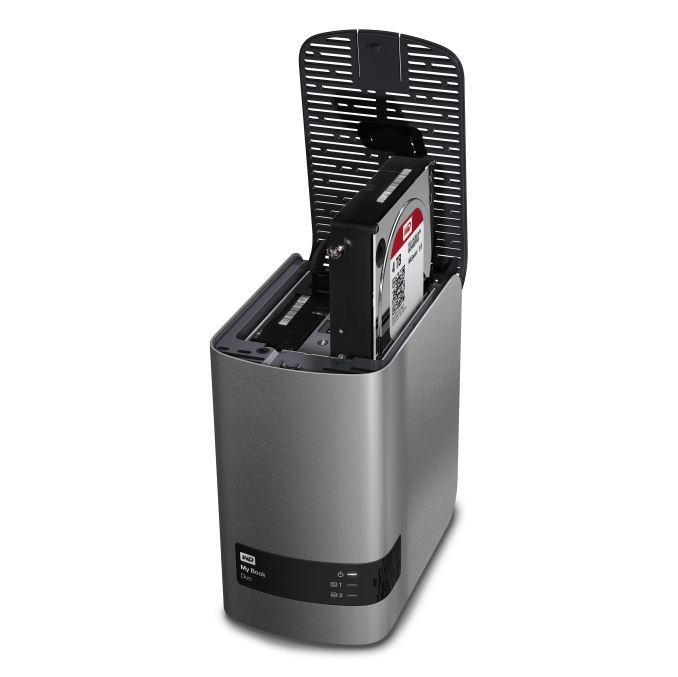Western Digital Launches My Book Duo 2-bay USB 3.0 DAS
by Ganesh T S on June 24, 2014 8:00 AM EST- Posted in
- Western Digital
- RAID
- DAS
- My Book

Even as the consumer NAS market continues to experience rapid growth, it is impossible for consumers to have really fast access to data when the storage is bottlenecked by the speed of their network link. Single hard disks, by themselves, can hardly saturate today's high-speed direct-attached storage (DAS) interfaces such as eSATA, USB 3.0 and Thunderbolt. Users needing fast transfer rates (while maintaining the higher cost-effective capacities that hard disks provide) need to go in for RAID solutions. These tend to perform well for certain common workloads (multimedia handling).
Today, Western Digital is launching a new member in the My Book lineup of DAS devices, the My Book Duo. The company is no stranger to dual-disk RAID-0/-1 capable solutions, having released a USB 2.0 / Firewire 800 capable unit back in 2011 and a first-generation Thunderbolt device in 2012 along with a high-performance variant using VelociRaptor drives later in the same year. All these used software RAID, and that is where things are changing now.
The My Book Duo comes with hardware RAID (and hardware encryption, if opted for). It has a USB 3.0 interface. There are two additional USB 3.0 ports in a hub configuration at the rear of the unit, claimed by WD to be a handy add-on when users want to charge their mobile devices without desk clutter. WD Red drives are used internally (pre-configured in RAID-0). WD includes a complete software suite (WD SmartWare Pro, Acronis True Image Software, Dropbox cloud integration etc.) with the device.
The design of the chassis seems to be the same as what was used in previous two-bay solutions that supported replacement of disks by users (such as the My Cloud EX2). The unit is available today in 4, 6 and 8 TB capacities with suggested prices of $280, $350 and $450 respectively.
Source: Western Digital










11 Comments
View All Comments
nathanddrews - Tuesday, June 24, 2014 - link
RAID-0 by default? Seems like if you're using software management anyway, JBOD presented as a drive pool with the option of either performance or redundancy at the folder level would be a lot safer for users. While not Lacie-exorbitant, charging $100 for the enclosure and software feels a bit high.SniPerfidy - Tuesday, June 24, 2014 - link
Agreed. You're paying for the name and support, I'd guess.Flunk - Tuesday, June 24, 2014 - link
For their target market, people who don't understand computers, I can see why they'd have to do that. It stops them having to field 100,000 calls asking why their new removable disk shows up as two drives or only has half the advertised capacity.Sadly they do have to play to the lowest common denominator. Anyone who knows what they're doing can fix this in a few minutes.
bill.rookard - Tuesday, June 24, 2014 - link
I don't know why they didn't just create a 'configuration start page' where you send your browser to a default IP address then pick your redundancy (RAID 1/JBOD) with details on how it affects your storage size vs safety - then allow further configuration for important folders (create redundancy) for those who don't choose a RAID 1 setup.Should have been a pretty trivial, but very useful addition.
Hrel - Tuesday, June 24, 2014 - link
lol, people would never EVER read it. I guarantee it.Flunk - Tuesday, June 24, 2014 - link
That would create support calls rather than prevent them. You cannot underestimate the idiocy of some people.nathanddrews - Tuesday, June 24, 2014 - link
That's why I said "JBOD presented as a drive pool", so the software only shows the user 8TB, but has no idea how it is arranged, but perhaps I wasn't clear enough. My home server is many drives that I have arranged into a single 35TB pool that the OS sees as "Drive Z". Then the very simple software asks me if I want to make the whole pool redundant and/or specific folders and how many copies I want maintained.I think the fallout that would be nothing compared to losing 8TB of RAID0. Seriously.
Flunk - Tuesday, June 24, 2014 - link
Hardware doesn't support something so complicated.nathanddrews - Tuesday, June 24, 2014 - link
Doesn't have to, it would all be software on the client computer.Hrel - Tuesday, June 24, 2014 - link
You guys and your mirrored RAIDS. What value does running a mirrored RAID provide when you have all the data on the NAS backed up? A NAS/DAS is not a backup solution. It's a convenience.